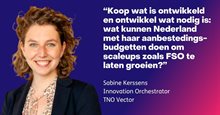
A more sustainable port: the fuel strategy for HIC Rotterdam
How do you make Europe’s largest port sustainable? Answering this question is currently the number one challenge facing the port of Rotterdam. Together with a number of project partners, TNO Vector has developed a strategy to help HIC (Harbour Industrial Cluster) Rotterdam become more sustainable.
How do you achieve sustainability across a vast port area in which more than 120 industrial companies operate and where good transport infrastructure is essential? Is a port without fossil fuels even possible? That goal is still a long way off, including in Rotterdam’s port area.
The port of Rotterdam plays an important role in international freight transport and is even the second-largest fuel cluster in the world. HIC Rotterdam is still run almost entirely on fossil fuels – and that’s a problem.
The big question is how the port will achieve its green ambitions while at the same time maintaining or even strengthening its strong economic position.
Different interests, challenges, and goals
In a situation that involves many different parties and stakeholders, agreeing on things can be pretty difficult, including the approach to take to reduce CO2 emissions.
What benefits one stakeholder may have very negative implications for another. In such a situation it helps to have a neutral party at the table – one with experience of managing complex innovation processes.
The parties concerned at HIC Rotterdam and TNO Vector had already worked together during an earlier project on e-fuels. Later, a plan emerged within HIC Rotterdam to translate these results into a strategy for also working with e-fuels. TNO Vector was quickly identified as a neutral party that could take the lead in developing this strategy.
Listening carefully is the first step
With complex issues such as this, expecting to have a possible solution on the table that everyone agrees with after just one session is unrealistic. The first step is to listen carefully to each other and look for common interests.
The parties concerned within HIC Rotterdam are all facing a sustainability challenge and are largely dependent on each other to achieve their goals. This is an insight that helps them set to work on the problem.
Joint strategy for HIC Rotterdam
After a while the outlines of a sustainability strategy began to emerge more clearly. The strategy for HIC Rotterdam is centred around reducing CO2 emissions in heavy transport by using e-fuels and green hydrogen. Renewable fuels are expected to play an important role in the transport sector from 2030.
It therefore makes sense to anticipate this development. This quickly gave rise to the following question: should we invest heavily ourselves right now in the large-scale production of e-fuels and hydrogen or rely mostly on imports? To find a good answer to this question, several future scenarios were developed.
Taking geopolitical developments into account
The strategic considerations were not just about price. It is interesting to investigate where it is cheapest to produce e-fuels and hydrogen, of course, but geopolitical developments also play a role. In the future hydrogen could be one of the critical raw materials over which the Netherlands and the EU are keen to achieve strategic autonomy.
Due to geopolitical developments, it was decided to import the lion’s share of e-fuels, but to produce some of the necessary hydrogen locally. Conveniently, within HIC Rotterdam investments are already being made in electrolysis capacity. Projects are also now under way to enable the large-scale importation of ammonia and other hydrogen carriers. These projects are a perfect fit with the newly formulated strategy.



